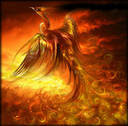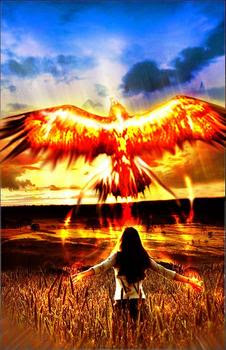
by D. J. Conway
The Phoenix is known in various forms and by various names throughout the Middle and Far East, the Mediterranean, and Europe, as a symbol of resurrection. The name Phoenix may have come from the Greek phoinix and may be related to phoinos (blood-red). Although it was an enormous bird, it had certain characteristics of the eagle, pheasant, and the peacock.
The earliest known Greek reference to the Phoenix was by Hesoid in the eighth century B.C.E. Such Greek and Roman writers as Tacitus, Ovid, Pliny, Herodotus, and Hesoid referred to the Phoenix either as the Arabian Bird or the Egyptian Bird. An extremely gentle creature, it was said to weep tears of incense, while its blood was balsam.
There are two ancient records of first-hand sightings of a Phoenix: one by Pliny, who saw one exhibited in the Roman Forum during the reign of the Emperor Claudius; another by Clemont in the first century C.E.
The Phoenix was a graceful bird, with brilliant plumage and a distinctive tuft of feathers at the back of its head. There are at least three different descriptions of the plumage colors of the Phoenix. One says that the head, breast, and back are scarlet or reddish-gold, and the iridescent wings are many colors. Its feet are a Tyrian purple hue, while its eyes are sea-blue. Another says the body is plum-colored with a scarlet back and wing feathers, a golden head, and a long tail of rose and azure. The third description states that the Phoenix is a royal purple with a golden neck and head. It is possible that these descriptions are of the Phoenix in various stages of its life.
Tradition says that the Phoenix fed only on air, harming no other creature. It lived a solitary life in a far-away land, coming to human-inhabited land only when it was ready to die. The length of a Phoenix's life differs from ancient writer to writer; most believed that it lived for a thousand years.
When the Phoenix knew its time had come, it flew to Arabia where it gathered myrrh, laudanum, nard, and cassia. Carrying a great load of these fragrances in its wings, the Phoenix flew on to Phoenicia. There, it chose the tallest palm tree and built a nest in it from the essences it had brought. At the next dawn, the great bird faced the rising Sun and sang in a beautiful voice. The heat of the Sun ignited the fragrant spices, and the Phoenix died in its own funeral pyre.
After nine days, a fledgling Phoenix rose out of the ashes. A few days later, when its wings were strong enough, the young Phoenix gathered the ashes of its parent and flew them to Heliopolis in Egypt. Thousands of ordinary birds accompanied it on its journey. There, the Phoenix put the ashes of its parent on the altar in the Sun temple. Then it flew toward the east and its distant home.

Other writers of the Phoenix story disagree on several points. Some said that instead of flying to Phoenicia with its spices, the Phoenix flew directly to the temple at Heliopolis and built its funeral pyre on the altar there. Others believed that the priest of the Sun temple gathered the spices and prepared the next for the Phoenix. A few writers recorded that the Phoenix did not rise straight from the ashes, but rather spent three days in a worm-like form before turning into the glorious Phoenix.
The Phoenix never died permanently. Legend says it existed when the universe was created and that it knows secrets of life and reincarnation even the deities do not know.
Humans are fascinated by the sweet song of the Phoenix, and the bird is friendly to humans, although it seldom concerns itself with human affairs.
A similar mythological Egyptian bird was the Bennu, a heron-like bird. The Bennu was born in a spice-lined nest in a sycamore tree. It too made its own funeral pyre in which it died. Its first flight, after being reborn, was accompanied by thousands of ordinary birds. In fact, "Bennu" in Egyptian and "Phoenix" in Greek both mean "date palm." The Bennu was sacred to Osiris and Ra, and a symbol of the Sun and resurrection. It also represented the morning star.
The Egyptian Phoenix was called the "Lord of jubilees," and was considered to be the ba (spirit) of the Sun God Ra. At one point in the Book of the Dead, the deceased says, "I have gone forth as a Phoenix." In Heliopolis, the Bennu was said to live in the benbenstone (obelisk) or in the sacred willow.
Queen Elizabeth I had a Phoenix engraved on her medals; Mary Queen of Scots also used the same emblem. Jane Seymour, who died giving birth to Edward VI, had a Phoenix crest, which her son later used.
In Mesopotamian art, the Phoenix may have been symbolized by the horned and winged solar disk. Ancient bas-reliefs show this winged disk also having tail-feathers, legs, and claws of a bird. Often this winged disk also had horns. The winged disk of Abura Mazdah on a relief at Persepolis distinctly shows this disk with tail-feathers and bird's legs and feet.
Alchemists used the Phoenix to symbolize the color red and the successful end of a process, while medieval Hermeticists used the Phoenix as a symbol of alchemical transmutation. The word Phoenix was also used to identify one of the secret alchemical formulae.
The ancient Mysteries used the sign of the Phoenix to symbolize the immortality of the human soul and the great truths of esoteric philosophies revealed only through special initiations. In some ancient Mystery Schools, accepted initiates were referred to as Phoenixes, or those who had been "born again."

In ancient Egyptian mythology and in myths derived from it, the phoenix or phœnix is a mythical sacred firebird.
Said to live for 500 or 1461 years (depending on the source), the phoenix is a bird with beautiful gold and red plumage. At the end of its life-cycle the phoenix builds itself a nest of cinnamon twigs that it then ignites; both nest and bird burn fiercely and are reduced to ashes, from which a new, young phoenix arises. The new phoenix embalms the ashes of the old phoenix in an egg made of myrrh and deposits it in the Egyptian city of Heliopolis ("the city of the sun" in Greek). The bird was also said to regenerate when hurt or wounded by a foe, thus being almost immortal and invincible — a symbol of fire and divinity.
Although descriptions (and life-span) vary, the phoenix (Bennu bird) became popular in early Christian art, literature and Christian symbolism, as a symbol of Christ, and further, represented the resurrection, immortality, and the life-after-death of Jesus Christ.
Originally, the phoenix was identified by the Egyptians as a stork or heron-like bird called a benu, known from the Book of the Dead and other Egyptian texts as one of the sacred symbols of worship at Heliopolis, closely associated with the rising sun and the Egyptian sun-god Ra.
It's spring again, and in spring the Earth is re-born. Immortality is a central concept of all mythology, to the most ancient times. The Phoenix is the most enigmatic legend of all. It is a great bird that incinerates itself, then is born again from it's own ashes.
The legend is believed by many scholars to have originated in the Middle East, but it is so old and obscure that it is impossible to tell where it really began. The only thing scholars seem to agree on is, as Socrates once said, we know only that we know nothing when it comes right down to it. In every version of the legend, the bird is immortal.
It seems to come from pre-historic spirituality. It represents our mortality, the very foundation of our being. A Phoenix represents the never-ending cycle of life; our own and of the universe itself.
In Greek and Egyptian mythology, the Phoenix is tied to the God of the Sun. it In Greek legend, he lives in the Middle East, by a well. It bathed in the well every day, and sang, as many of us do, in the bath. But the song of the Phoenix was so beautiful that the sun itself stopped first at it's well before making his daily journey across the sky.
Legend says that there is only one phoenix. Every 500-1,461 years, when it knows death is near, it builds a nest of sweet scented wood and then bursts into flame. It then re-emerges from the fire and embalms the ashes of its former self in an egg all of myrrh. The Phoenix flies the egg to the Sun God.

[from Magickal, Mystical Creatures by D. J Conway]




